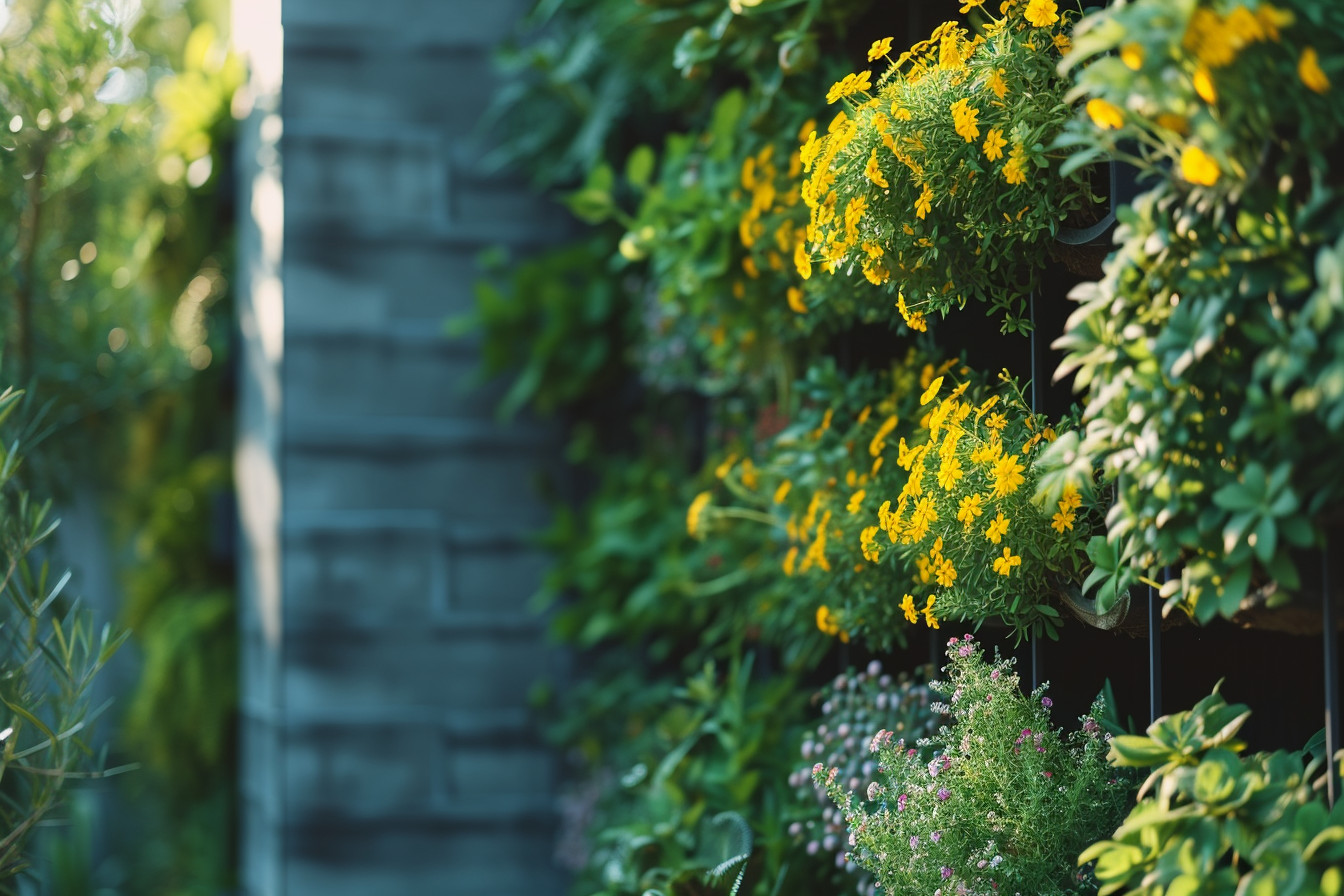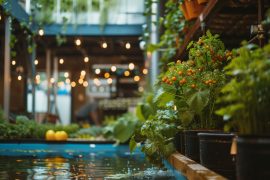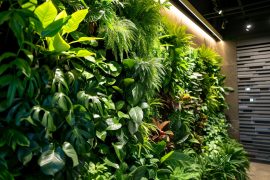I’ve always found something incredibly peaceful about tending to a garden. There’s a kind of magic in watching things grow, in nurturing life in the calm of my own space. It’s a slice of nature’s tranquility, an escape from the hustle and bustle without stepping outside my door.
But what if you’re short on space or don’t have a backyard? That’s where indoor vertical gardening comes in. It’s a game-changer for city dwellers like me, transforming bare walls into lush, living tapestries. I’m here to share the basics so you can maximize both space and beauty in your home.
From hanging planters to wall-mounted greenery, I’ve seen and tried it all. And let me tell you, it’s not just about aesthetics; it’s about creating a harmonious sanctuary where every inch of room serves a purpose. Let’s dive into the world of vertical gardens together – trust me, it’s easier than you think, and the rewards are well worth it.
What is Indoor Vertical Gardening?
Imagine walking into a room and being greeted by lush greenery cascading from the walls and suspended artfully in mid-air. That’s the essence of indoor vertical gardening—a serene symbiosis of nature and living spaces. Indoor vertical gardening is, at its core, a method to cultivate plants using vertically suspended panels or structures.
In my years of gardening, I’ve seen indoor vertical gardens transform blank walls into vibrant living art. These vertical arrangements can include a variety of plant species, from ferns and succulents to edible herbs and vegetables. The versatility here is stunning, and beyond adding a pop of nature’s colors to homes and offices, it taps into a deeper connection with the environment.
Creating Your Green Canvas
Vertical gardening isn’t just for professional gardeners or those with a deep understanding of horticulture. Anybody can create their own green nook. Here’s the thing: once you’ve decided on the type of garden you want, you’ll need to consider the practical aspects such as light exposure, watering needs, and the weight of your garden. Lighting is particularly crucial, as it can make or break your plant’s health, stimulating growth and ensuring vibrancy.
Techniques and Styles
When I first dipped my toes into the world of vertical gardening, the numerous techniques felt overwhelming. But don’t worry; once you become familiar with a few basic styles, it’ll all seem a lot more manageable. For instance, some folks might opt for pocket gardens, which involve a system of pockets that hold plants in place and can be easily hung on the wall. Then there’s the trellis approach for climbing plants—a simple yet elegant solution that adds depth and structure to your indoor oasis.
And don’t forget about hydroponic systems. They’re a tad more high-tech and involve growing plants in a water-based, nutrient-rich solution. Hydroponics can dramatically reduce water usage, a win for eco-conscious gardeners.
Benefits of Indoor Vertical Gardening
Whenever I slide my fingers into the soil or witness the first shoots of green pushing their way through the dirt, there’s this undeniable sense of peace that wraps around me like a warm blanket. It’s this tranquility, a kind of silent conversation between nature and me, that makes indoor vertical gardening so much more than just a space-saving solution.
A Slice of Serenity
In a world that’s always buzzing with activity, an indoor vertical garden becomes a slice of serenity. As I weave through the landscape of my own vertical garden, I’m often struck by the calm that it instills. It’s a personal retreat where the hum of the outside world fades away, and all that’s left is the gentle rustle of leaves and the occasional drip of water. It’s like having a miniature park within the four walls of my home.
A Learning Journey
Every plant I tuck into my vertical garden comes with its own set of needs and quirks. It’s a constant learning journey. Through my vertical garden, I’ve discovered the unique way hydroponic systems deliver nutrients directly to plant roots and how pocket gardens can be a playful yet efficient way to incorporate more greenery into my living space. I’ve had moments where a trellis technique has sparked conversations with curious friends eager to start their own gardens. Sharing this knowledge has been as rewarding as the gardening itself.
Simplicity in the Complexity
While vertical gardening may seem complex at first, I make it a point to break down the jargon into bite-sized, easy-to-understand pieces. Let’s take “hydroponics,” for instance. It might sound like something straight out of a science textbook, but it’s essentially just growing plants in water without soil. Simple, right? This way, everyone gets to enjoy the wonders of gardening without feeling overwhelmed by the technicalities.
Stories in the Leaves
I recall the time when I set up my first hydroponic system; it felt like uncharted territory. I learned quickly and enjoyed sharing each milestone with friends and family. Every plant in my garden has its own story, from the resilient herb that bounced back after I nearly overwatered it to the blooming flower that seemed to defy all odds in the dead of winter. These stories resonate with folks and often inspire them to create their own green spaces.
Choosing the Right Plants for Indoor Vertical Gardening
When I first started with indoor vertical gardening, I realized that not all plants are created equal for this purpose. Some thrive in the cozy confines of a living wall, while others prefer the sprawl of a traditional garden bed. So, here’s a bit of wisdom I’ve gained on which plants to beckon into your vertical oasis.
Lighting, as it turns out, is crucial. Plants that love basking in sunlight will only flourish if you’ve got a spot that captures those golden rays. I’ve found that herbs like basil and thyme are a good fit for areas with plenty of light. They don’t just bring flavor to your dishes; they add a punch of green to your space.
But hey, not all of us are blessed with sun-drenched apartments. For those less-lit areas, I’d recommend shade-tolerant plants like ferns or philodendrons. They’re like the understudies who steal the show when the lead can’t go on – constantly surprising you with their resilience.
Here’s something else to consider: Water needs can differ greatly from plant to plant. Getting this wrong is like throwing a snowball at a cactus – it’s not going to end well. Succulents are pretty forgiving if you forget a watering or two — I mean, we’ve all had those weeks. But leafy greens? They’ll need consistent moisture to stay lush.
I started grouping plants with similar thirst levels together; it’s a little trick that helps me keep my garden hydrated but not drowned. It also helps that I can tailor my watering routine in one go, rather than carting my watering can back and forth all day.
Deciding on the ultimate plant lineup for your vertical garden is kind of like drafting a fantasy football team. You need a balanced squad. Here’s a quick rundown of plants that’ve earned a spot in my vertical garden league:
- Edible: Strawberries, lettuce, and a variety of herbs.
- Flowering: Begonias and pansies for that pop of color.
- Foliage: Spider plants and ivies, because they just never stop impressing with their cascades of leaves.
I’ve embraced the cascading effect of certain plants, letting them spill over their containers like a waterfall of greenery. It’s a visual feast that turns your wall into a living piece of art.
Designing Your Indoor Vertical Garden
When I think about the tranquility that an indoor vertical garden brings, I’m reminded of the subtle but profound connection it fosters with nature. Imagine a living tapestry, where the greens and blooms do more than just beautify a space; they evoke a sense of peace and harmony. In designing such a garden, it’s pivotal to reflect on the kind of serenity you want to introduce to your environment.
Light Dynamics Influence Plant Choices. I’ve personally oscillated between different plant varieties, keeping in mind the interplay of light and shadow. Remember, the elemental qualities in your space will guide the selection of plants that not only thrive but also contribute to the overall aesthetic you’re aiming for.
It’s educational for both me and potential gardeners to explore the lineage of vertical gardening. Looking back, this style made waves in urban landscapes, often a creative solution for the lack of horizontal spaces. Now, it’s not just about space-saving; it’s about creating a vertical oasis.
Planting isn’t just digging and sowing; it’s a meticulous art. I learned this the hard way, through trials and triumphs. As my expertise grew, so did my desire to make Gardening Terms User-Friendly. For instance, ‘hydroponics’ might sound intimidating, but it’s simply a way to grow plants in water with added nutrients – a brilliant fit for vertical gardens.
I’m asked often about Watering Systems in vertical setups. Drip irrigation or self-watering planters are godsends in these gardens, keeping moisture consistent. Plus, they’re a sustainable option, conserving water by delivering it directly to the roots.
Let’s talk examples. A friend crafted an edible wall in their kitchen. The fresh basil and mint just an arm’s length away while cooking? That’s convenience and beauty all rolled into one. This friend’s garden stirred up conversations and cravings alike, casting an enchanting spell over anyone who visited.
Designing these gardens can be A Story of Growth; Each plant added weaves into a narrative of personal growth and the blossoming of your gardening story. Whether it’s the joy I feel when my creeping vines unfurl new tendrils or the excitement of the first bloom from a flower I nurtured from seed, these moments are chapters of my ongoing garden saga.
Setting Up Your Indoor Vertical Garden
Imagine stepping into a room where air plants float like gentle green sprites, where vines scale the walls with an artist’s precision, where your favorite herbs and veggies are just an arm’s length away. That’s the sanctuary I’m here to help you create with your very own indoor vertical garden.
Starting from Scratch
First thing’s first, let’s talk about the foundation. You’ll need a strong structure to support your lush wall of greenery. I’ve had great success with modular panels that easily fit together. Think of these panels as the canvas for your living artwork. They can be made of various materials, like wood, metal, or recycled plastic – each giving a unique feel to your garden.
Selecting the Right Spot
You’ve got to pick the perfect location. It’s not just about the sunlight, but also about the view. After all, this is going to be the centerpiece of your room. Near a window is a classic choice because, let’s face it, those plants are solar power addicts. But don’t worry if you’re short on natural light; artificial grow lights have come a long way and can supplement beautifully.
Adding a Touch of Tech
And since we’re on the topic of simplicity, let’s chat watering systems. Trust me, you don’t want to be up a ladder every other day with a watering can. Drip irrigation systems are fantastic. They deliver water directly to the roots without you lifting a finger. It’s a bit of tech that respects the serene essence of your garden while making life easier.
Choosing Your Greens
You’re gonna love this part – selecting your plants. This is where your garden starts to reflect your personality. Do you lean towards the lush foliage of ferns or the culinary promise of an upright herb garden? Maybe a mix of both? Remember what I said earlier about light and shadow – it’s like painting with plants.
My buddy Dave, he’s all about the herbs. He’s got this verdant corner in his kitchen where basil and mint spill over. He says it’s like living in a living cookbook. A vertical garden can be as functional as it is beautiful.
Bringing It All Together
Maintenance Tips for Indoor Vertical Gardens
Stepping into my garden feels like crossing into a tranquil sanctuary, where the hum of daily life softly fades into the background. The gentle routine of tending to my vertical oasis is not just a chore, but a serene ritual that connects me to the rhythms of nature – right in my living room.
Simplify Watering with Technology
I’ve always been fascinated by the clever use of technology in the garden. It’s like weaving together two different worlds – the ancient art of cultivation with the sharp edge of modern innovation. In the spirit of making things easier, I turned to automated drip irrigation systems early on. Plants receive a steady moisture supply without me having to water them individually, a godsend for busy days.
Manage Light to Mimic Nature
I quickly learned that light is a key player in the wellbeing of plants. For those leafy friends that crave the sun, I use artificial grow lights. They’re pretty smart – I can adjust them to mimic the natural ebb and flow of daylight, ensuring my plants bask in a customized glow that keeps them thriving.
Regular Pruning Keeps Things Tidy
Pruning is another aspect that I can’t emphasize enough. It’s not just about aesthetics, although a neat and tidy vertical garden certainly has its charms. Pruning helps prevent overgrowth, which in turn averts issues like poor air circulation and uneven light exposure – both can become perfect breeding grounds for pests and diseases.
Constant Vigilance – The Pest Patrol
Speaking of pests, I’ve been through my fair share of invasions. Maintaining a close watch is your best defense. If I spot any signs, like discoloration or nibble marks on leaves, I take immediate action. I prefer non-toxic remedies – from homemade soap sprays to introducing beneficial insects. My vertical garden is not just a spectacle of beauty; it’s a stronghold against tiny would-be plant conquerors.
Fertilizing – Not Too Much, Not Too Little
Feeding your plants is as much an art as it is a science. I got a few raised eyebrows from my friends when they saw my meticulous fertilizing schedule. But it pays off. The trick is to find that perfect balance where your plants are getting just the right nutrients without going overboard. Too much love can be just as harmful as too little.
Troubleshooting Common Issues in Indoor Vertical Gardening
When I first took a dive into the world of indoor vertical gardening, I reveled in the stillness that came with my green oasis. There’s something truly serene about nurturing plants upwards towards the light. However, let’s be honest—sometimes my peaceful retreat faced a few hiccups. Over the years, I’ve learned to manage common issues that can arise.
Uneven Plant Growth had me scratching my head until I remembered how plants in nature compete for sunlight. It turns out, the lower shelves of my vertical setup were getting overshadowed. To fix this, I introduced more Grow Lights, ensuring even coverage. It’s like giving each plant its personal patch of sunshine.
Next up, watering can be a tricky business. I noticed that Water Distribution wasn’t always even, which made some of my plants look less perky than others. After a bit of tinkering, I found the solution. Here’s a pro tip: check your Irrigation System for clogs, and always ensure the topmost plants don’t hog all the water. It takes a bit of patience, but once it’s done, it’s a sight to behold.
Let’s talk about Nutrient Imbalances. I used to sprinkle fertilizers like I was seasoning a stew, not ideal. Overfertilizing can burn plant roots, while underfertilizing leaves them malnourished. Striking that right balance is key. I’ve started testing my soil regularly and adjusting nutrient levels accordingly. Remember, moderation is your friend!
And who could forget the uninvited guests? Pests. In my garden, aphids and spider mites were a recurring theme, and they loved my little sanctuary as much as I did. I found that a Regular Cleaning Schedule and introducing beneficial insects like ladybugs were my saving grace. Also, organic pesticides can be effective, but always use these as a last resort.
Disease can derail the most tranquil garden in a heartbeat. Stagnant air and high humidity, wonderful for some tropical plants, also breed fungal and bacterial issues. To counter this, I ensure good air circulation and keep humidity levels in check. A small oscillating fan can work wonders here and getting that balance right feels like conducting a symphony, where each note is crucial to the harmony of the whole piece.
Conclusion
So there you have it—my guide to starting your own indoor vertical garden. It’s a fantastic way to bring a bit of the outdoors inside and make the most of your space. Remember to keep an eye on your plants and tweak your setup as needed. With a little patience and care, you’ll have a lush, green oasis that’s not only beautiful but also incredibly rewarding. Happy gardening!









